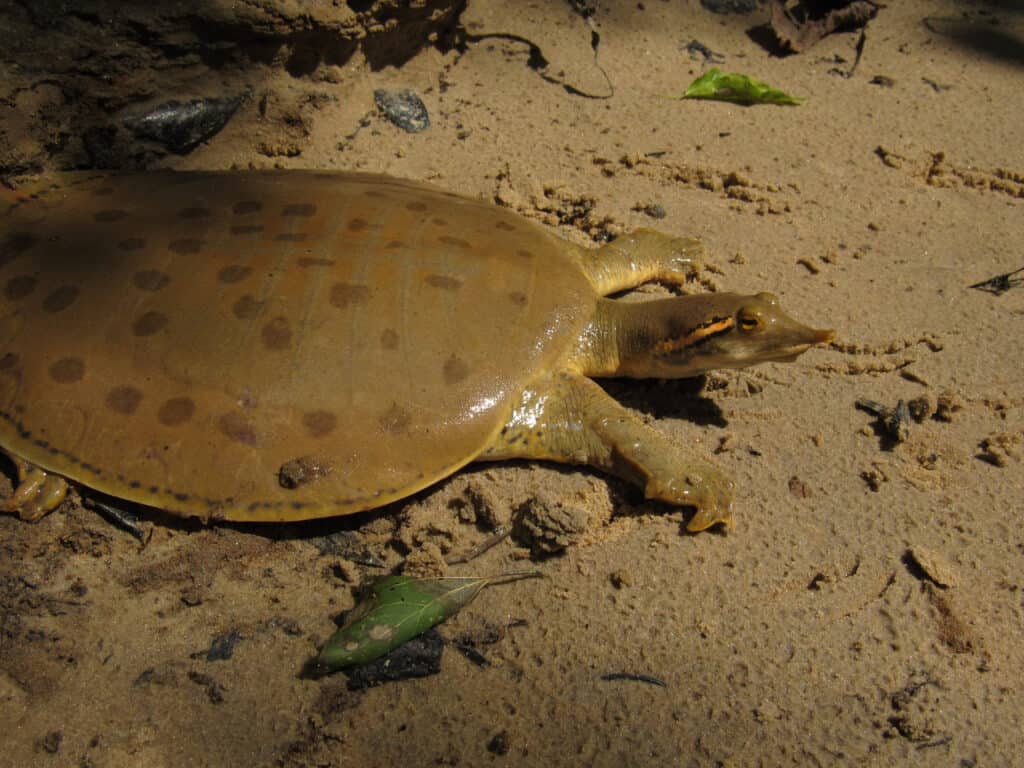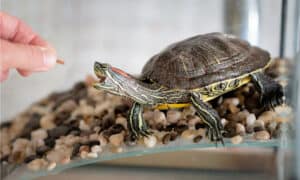Softshell turtles are distinctive species in the Trionychidae family. They are recognized by their pliable shells and lack of horny scutes, which are typical of most turtle species.
These turtles are found in parts of Asia, Africa, and North America where they inhabit temperate and tropical regions. Their habitat ranges from small freshwater ponds to large rivers and lakes, with some species adapting to brackish water conditions. Softshell turtles can vary in appearance and size depending on their species, and only a few are kept as pets.
The Different Species of Softshell Turtles

Softshell turtles have pliable, leathery shells that lack bony plates.
There are around 25 different species of softshell turtles placed in various genera and two extant subfamilies.
Let’s take a look at the most common species of softshell turtles below.
- Florida softshell turtle (Apalone ferox)
- Smooth softshell turtle (Apalone mutica)
- Spiny softshell turtle (Apalone spinifera)
- New Guinea giant softshell turtle (Peloychelys bibron)
- African Softshell turtle (Trionyx triunguis)
- Chinese softshell turtle (Pelodiscus sinensis)
- Malayan softshell turtle (Dogania subplana)
- Southeast Asian softshell turtle (Amyda ornate)
- Yangtze giant softshell turtle (Rafetus swinhoei)
Characteristics of Softshell Turtles

Pig-like noses and elongated snouts are distinctive features in softshell turtles.
©iStock.com/Brian Reinke
All softshell turtles have one thing in common – a soft, pliable carapace (upper shell). Their shells are soft because their carapace lacks bony plates, and instead have a leathery appearance and smooth texture. Their shells offer them little protection from predators, so they rely on camouflage instead.
These turtles have elongated necks with narrow snouts. Most softshell turtles have unique noses that are long and pig-like. They use their nose to breathe in shallow water or when they cover the rest of their body in mud and sand. Softshell turtles are not very colorful and generally have green, brown, or tan bodies to blend into their environment.
Softshell turtles are primarily carnivores and ambush their prey, but some species eat vegetation. They are mostly entirely aquatic but will surface to bask or lay eggs in the sand.
Softshell Turtle Size
Softshell turtles can vary in size, usually between 6 to 40 inches long. The smaller species of softshell turtles such as the spiny and Chinese softshell turtles reach around 6 to 14 inches long. Whereas the largest species, the Rafetus swinhoei or Yangtze giant softshell turtle, grows to 40 inches long. Yangtze giant softshell turtles can weigh up to 275 pounds when fully grown, slightly heavier than some alligator snapping turtles. However, most species are within the six-to-40-pound weight range.
Female softshell turtles are often significantly larger than the males, sometimes up to twice the size. They are also heavier and have faster growth rates.
Lifespan of Softshell Turtles
Like most turtles, softshell turtles have long lifespans spanning several decades. The average lifespan for softshell turtles is between 20 to 50 years, although they can live much longer. In captivity, softshell turtles are a lifelong commitment for many people. These turtles can easily exceed their 50-year lifespan with proper care and access to veterinary treatment when needed.
Some softshell turtles live significantly longer in captivity because they may have a lower risk of dying from predation or disease.
Caring for a Softshell Turtle In Captivity

Out of the numerous species of softshell turtles, only a select few are kept as pets.
©Gabbie Berry/Shutterstock.com
Softshell turtles are not commonly kept as pets. This is mainly due to their large size, challenging husbandry, and aggressive temperaments that make them difficult to care for. The three species from the Apalone genus make the most popular pets, such as the spiny, smooth, and Florida softshell turtle.
If you decide to keep a softshell turtle as a pet, ensure that you purchase them from a reputable source. You should not take a softshell turtle from the wild to keep as a pet, as it is prohibited to remove them from the wild in Florida from May 1st to July 31. In some cases, a permit from appropriate wildlife authorities is necessary to own a softshell turtle.
So, what does softshell turtle care entail? Find out below!
Habitat
Your softshell turtle’s habitat is one of the most essential aspects of their care. These turtles require very large habitats with no less than 100 gallons of water. Many experts recommend a much larger habitat setup for juvenile and adult Florida softshell turtles because of their larger size.
While a standard rectangular fish tank might suffice as a grow-out tank for hatchlings, a stock tank of around 200 to 600 gallons is preferred. The bottom of their habitat should be covered with a sandy substrate to replicate their wild conditions.
Diet
Softshell turtles eat a carnivorous diet in captivity consisting of both pellets and live foods. They enjoy catching live foods like worms, crustaceans, small fish, and insects. A commercial turtle pellet should be offered alongside live foods every day for hatchlings. After six months, you can reduce how often you feed your softshell turtle to every two to three days. Always consult with your softshell turtle’s veterinarian before making any changes to their diet.
Water Quality
Most pet softshell turtles belong in freshwater with a pH level of 6 to 9. Their water should have zero traces of chlorine, ammonia, and nitrite. Chlorine can be removed from their water using a reptile-safe dechlorinator. The ammonia and nitrite levels should remain at zero after their habitat has undergone the nitrogen cycle. Softshell turtles can handle higher nitrate levels around 15 to 35 parts per million (ppm).
Filtration
All softshell turtles require a suitable filtration system in their habitat. A filter helps to keep their water fresh and moving while harboring beneficial bacteria that help process their waste. Most aquarium filters are suitable for softshell turtles, such as external canister filters.
Heating and Lighting

Like most turtles, softshell turtles need to bask for warmth and to soak up essential UV rays.
©iStock.com/Joshua Prieto
Most softshell turtles thrive at warm water temperatures ranging from 70° to 80° Fahrenheit (21° to 27° Celsius). The exact temperature will vary throughout their habitat, as softshell turtles need a hot basking area and another spot to cool down. An aquarium heater is necessary to maintain a comfortable water temperature and to prevent fluctuations.
A softshell turtle’s basking spot should be above the waterline and easily accessible. Furthermore, it should be able to hold their weight and support a comfortable basking position. The temperature underneath their basking lamp should be between 85° to 95° Fahrenheit (29° to 35° Celsius) and only needs to be on during the day.
Both UVB and UVA lighting are important for softshell turtles to synthesize vitamin D3 and regulate their activity. UV lighting is an absolute necessity for these turtles and has a major impact on their growth and overall health.
In Conclusion
Softshell turtles are a family of fascinating species, but only a handful make good pets. Over 20 species of these turtles are mainly found in freshwater habitats. Their most prominent features are their soft shell and pig-like nose that functions similarly to a snorkel. Although some species of softshell turtles are found in captivity, they are not the easiest to keep and require specialized care to thrive.
The photo featured at the top of this post is © Mark W. Holdren/Shutterstock.com
Thank you for reading! Have some feedback for us? Contact the AZ Animals editorial team.







